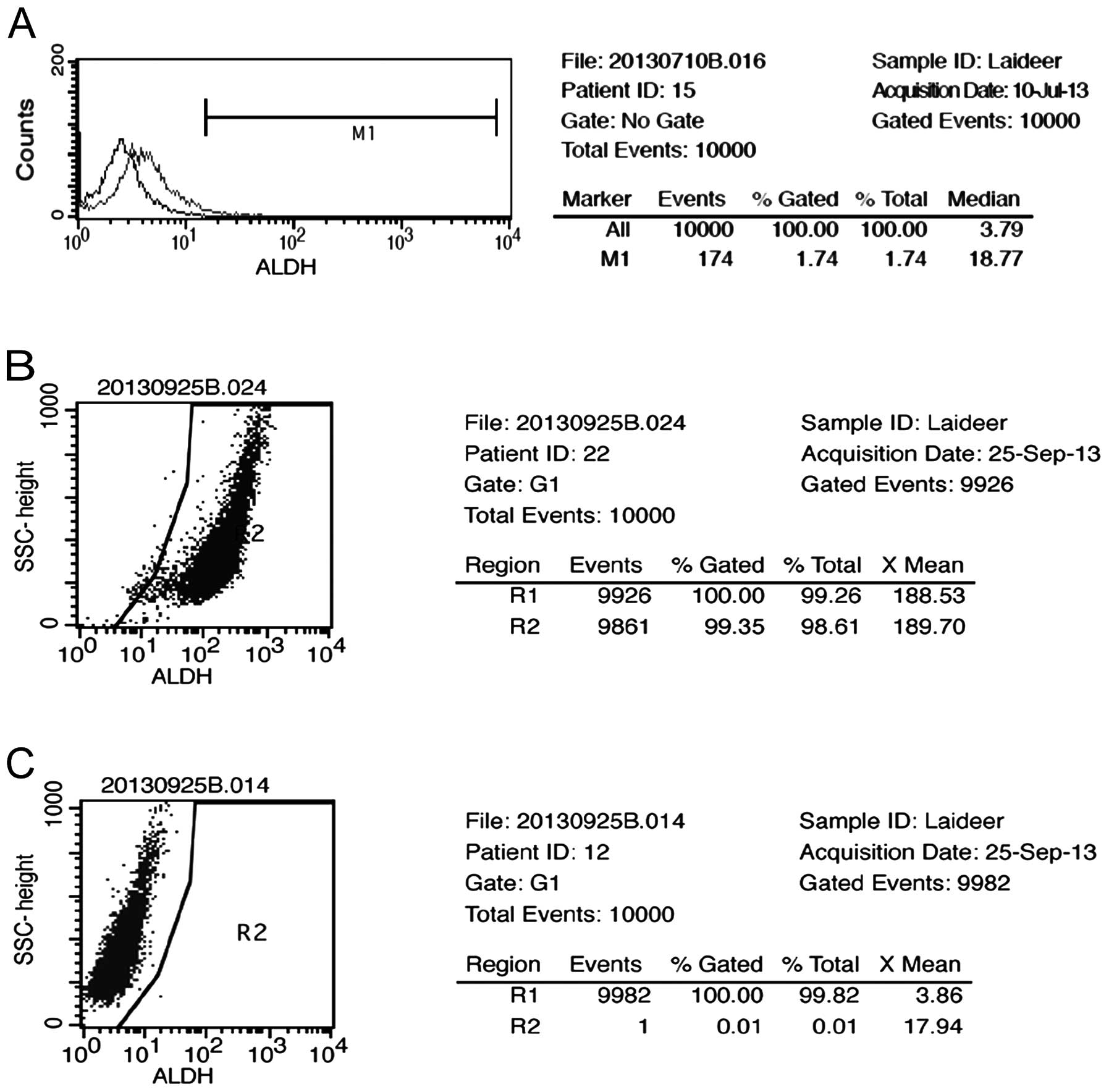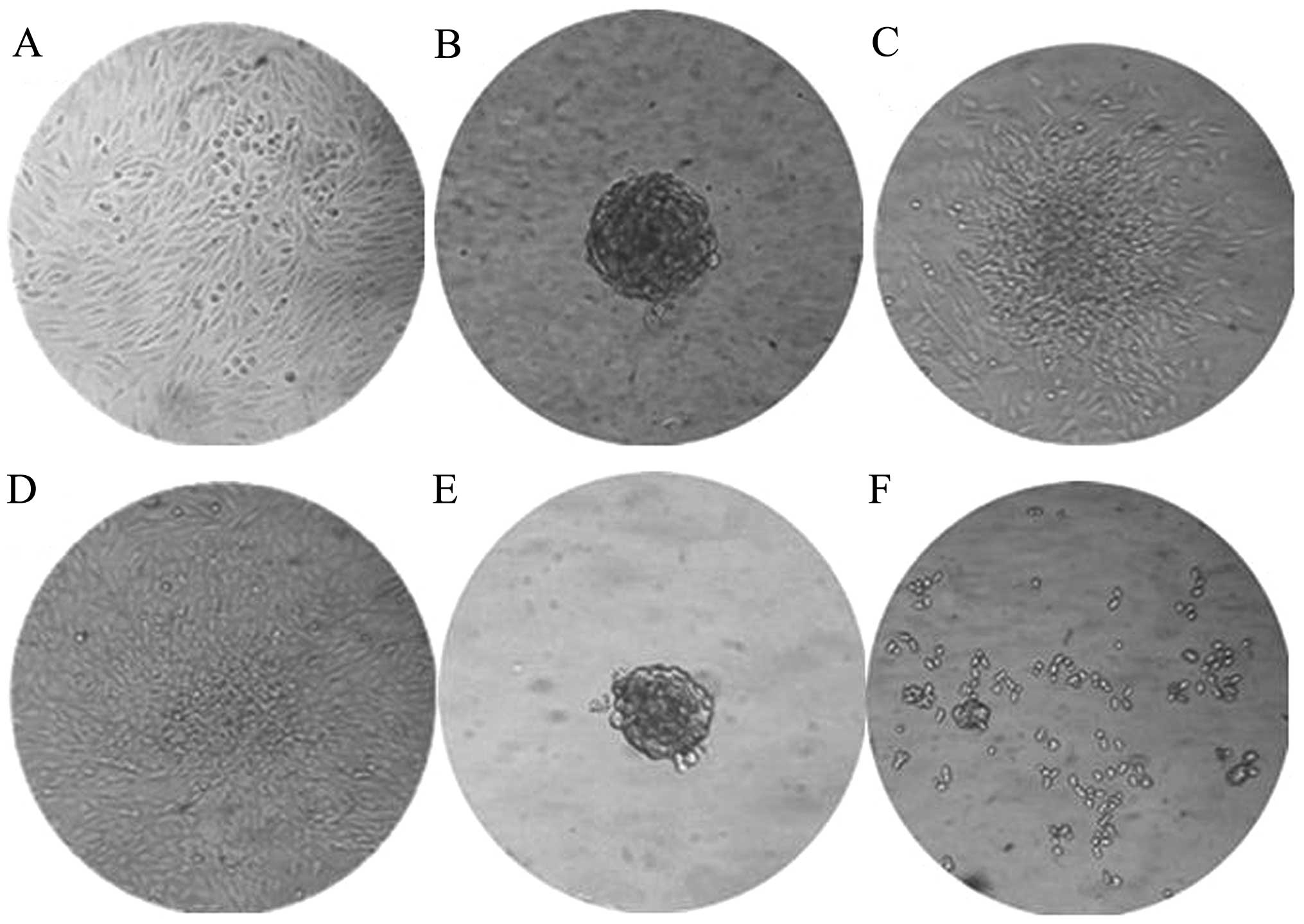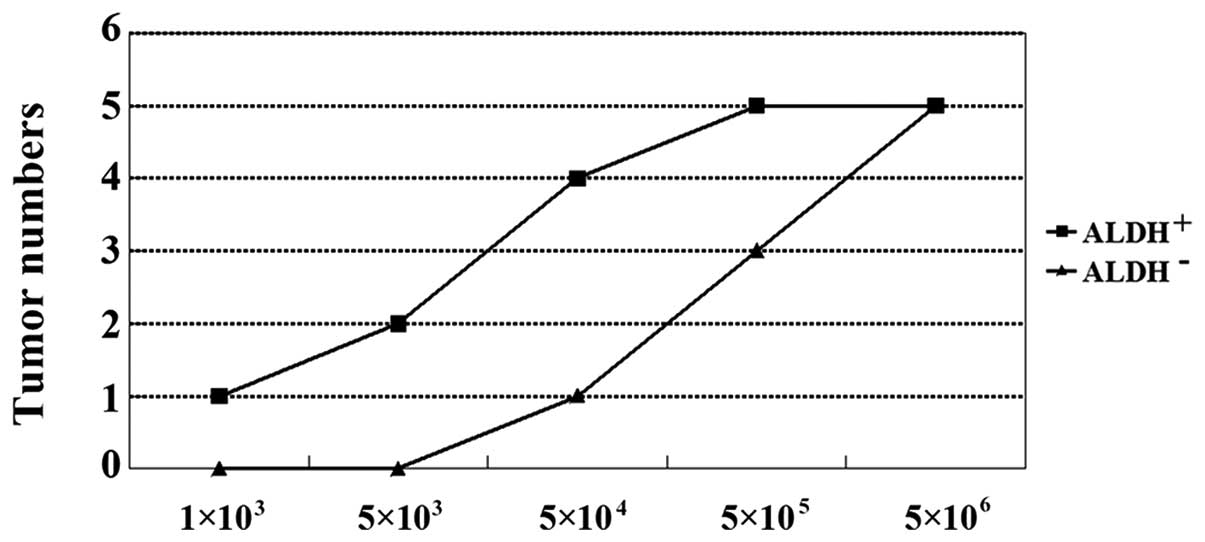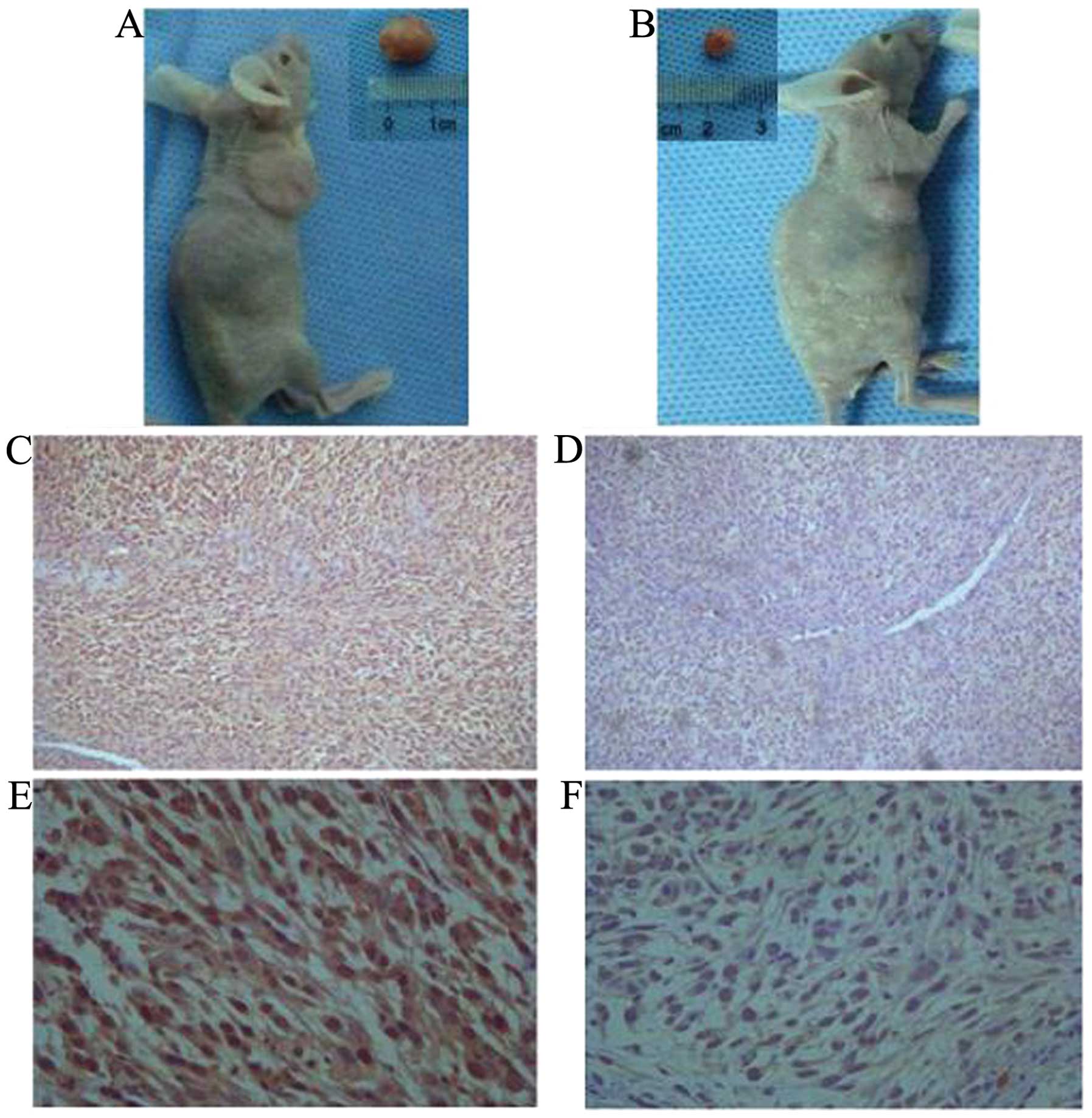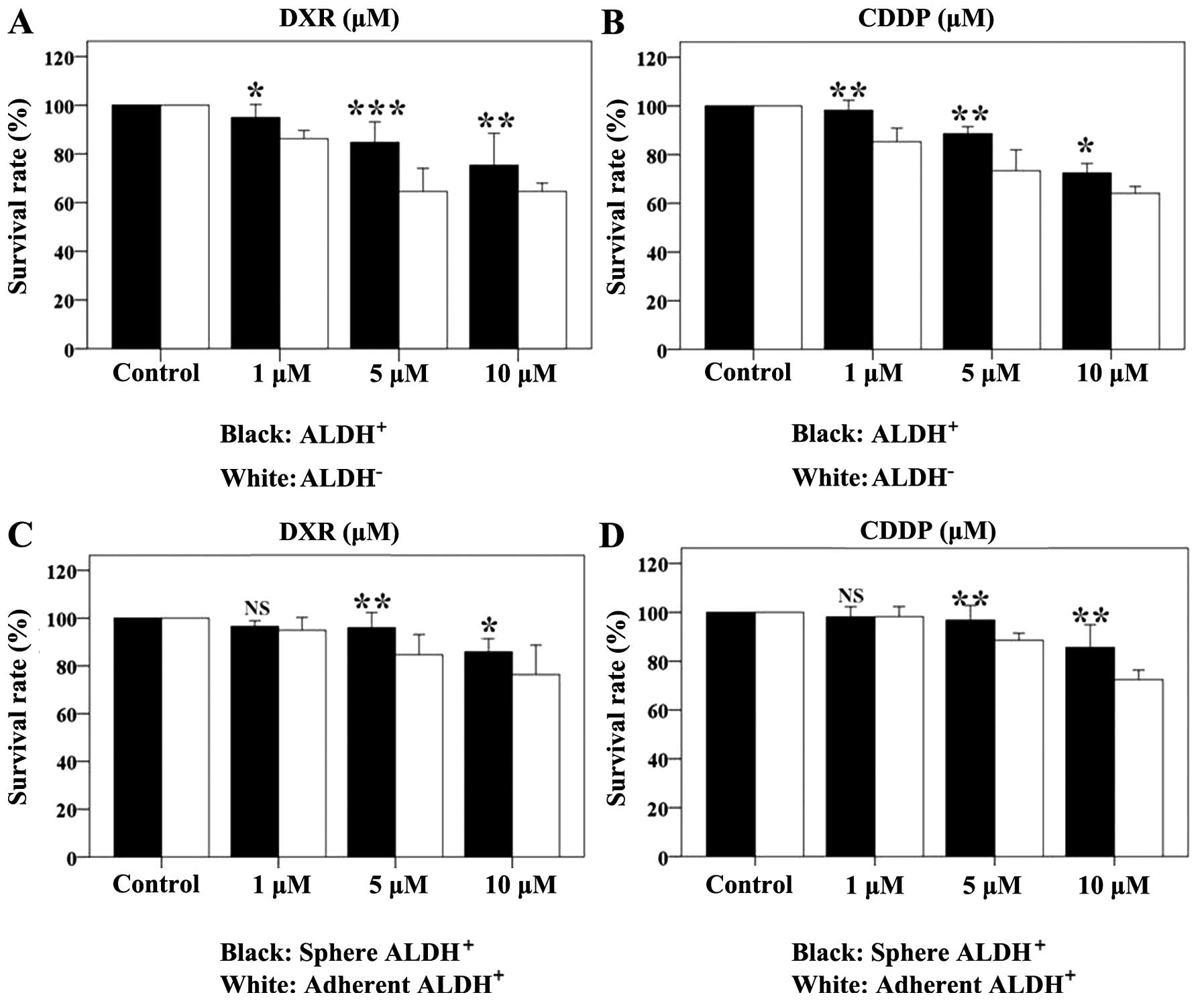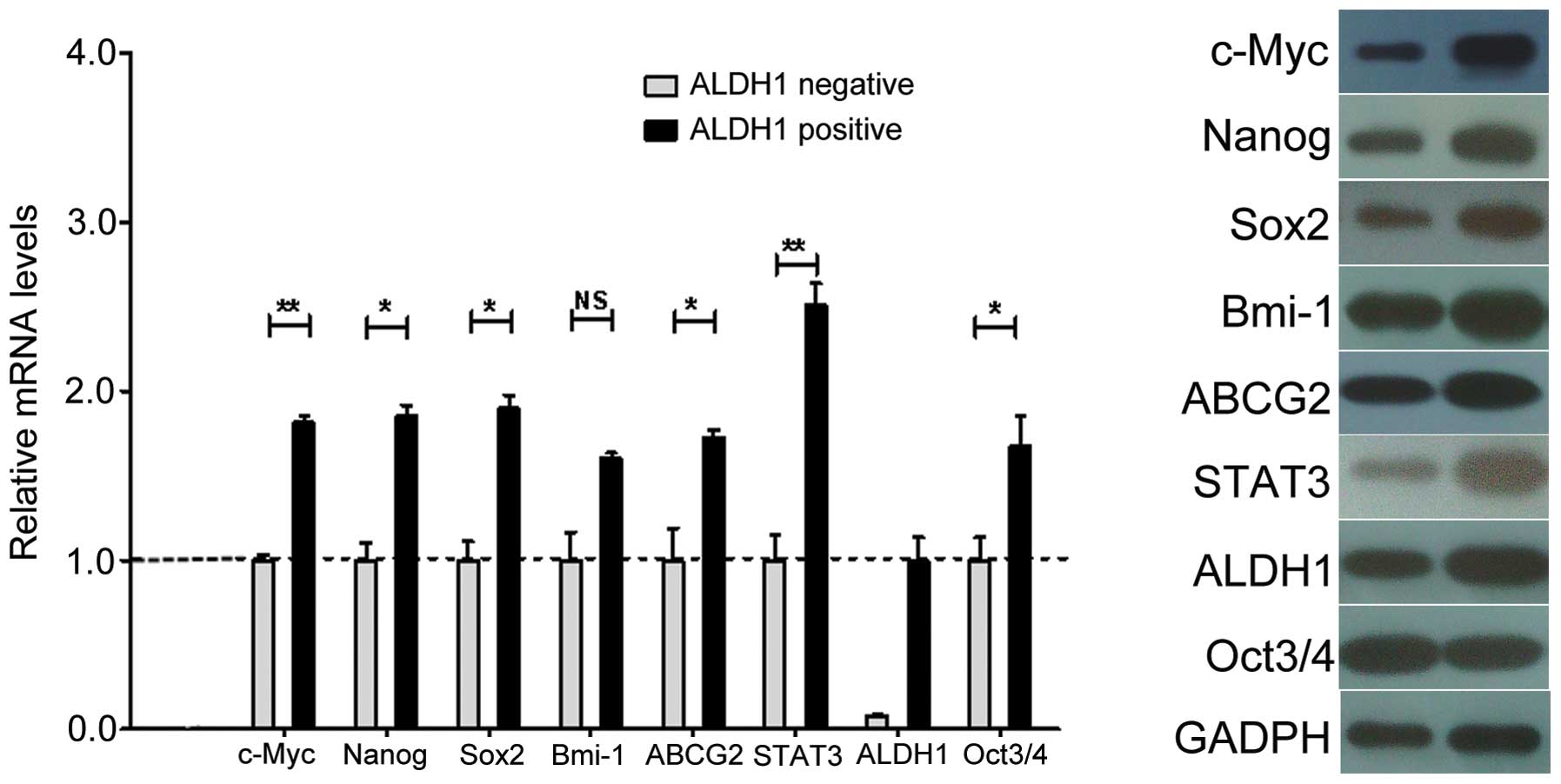The ALDH1+ subpopulation of the human NMFH‑1 cell line exhibits cancer stem-like characteristics
- Authors:
- Published online on: March 9, 2015 https://doi.org/10.3892/or.2015.3842
- Pages: 2291-2298
Abstract
Introduction
Cancer stem cells (CSCs) exist within tumors and are a unique subset of cells with the potential to self-renew, proliferate indefinitely, and differentiate into tumor cells (1,2). Present cancer therapies are known to leave behind some CSCs, explaining why tumor eradication is difficult to achieve (3–5). While the development of CSC-specific drugs may bring new hope to cancer therapy, there are few established models that allow the isolation and the study of CSCs.
Previous findings have shown that aldehyde dehydrogenase 1 (ALDH1) can be used as a CSC marker and is expressed in many stem cell types, including breast, lung, neuronal, and hematopoietic stem cells (HSCs) (6,7). ALDH1 is a member of a family of acetaldehyde dehydrogenase enzymes that oxidize acetaldehyde to acetic acid. In HSCs, ALDH1 can control retinol metabolism, and certain classes of retinoic acid may lead to the differentiation of hematopoietic progenitor cells (8). By contrast, immature HSCs are very rich in retinol, which enhances self-renewal (9). The above-mentioned results suggest that ALDH1 is a necessary factor for the HSC environment. A fluorescent ALDH substrate that passes through the cell membrane by free diffusion (Aldefluor® BAAA-ALDH) can be used to measure ALDH enzyme activity by quantitative flow cytometry (10–12).
Malignant fibrous histiocytoma (MFH) was identified and designated as such in the 1960s. However, the prognostic factors that are predictive of MFH outcome have not been well described (13). The majority of MFH tumors are defined as pleomorphic subtypes, and a few myxoid MFH cell lines have been established (14–16). Kawashima et al established the NMFH-1 cell line, which may prove a useful tool for studying CSCs (17).
In the present study, we isolated and characterized the population of NMFH-1 cells that have ALDH enzymatic activity, a trait characteristic of CSCs. The aim was to develop a model for the study of CSCs, which may ultimately provide insights into the clinical treatment of MFH. At present, it remains unknown whether the population of ALDH+ cells may be isolated from the human NMFH-1 cell line. Therefore, we defined the population of NMFH-1 cells with high ALDH enzymatic activity on CSC phenotypes. The findings may impact on the development of more effective MFH therapies.
Materials and methods
Cell lines and culture
The human NMFH-1 cell line used in the present study was obtained from the Niigata University Graduate School of Medical and Dental Sciences (17) and maintained at 37°C in a 5% CO2 atmosphere in RPMI-1640 supplemented with 10% fetal bovine serum (FBS). Aldefluor® (Stem Cell Technologies, Durham, NC, USA) was used to isolate the cell populations with high levels of the ALDH enzymatic activity. The cells were labeled with Aldefluor® reagent by collecting cells using 0.25% trypsin according to the manufacturer’s instructions, and single-cell suspension was prepared. The cells were washed with PBS and isolated by centrifugation prior to adding the product reagent according to the manufacturer’s instructions. The ALDH+ and ALDH− cells were then analyzed or isolated using a FACSAria.
Sphere formation
A single-cell suspension of 1×105 ALDH+ or ALDH− cells in serum-free RPMI-1640 medium was seeded in 6-well plates (Corning Inc., Corning, New York, USA). Each well contained 20 μg/l of EGF and bFGF, and wells were supplemented with 2 μg/l of EGF and bFGF every 24 h until spherical cell formations appeared. Following sphere formation, the cells were collected in a common culture bottle with complete media to observe whether the cells could be adhered to the wall. Other spheres were disrupted into a signal-cell solution to assess whether a second sphere could form.
Tumor implantation in nude BALB/c mice
Cells were collected and suspended and the concentration was adjusted with culture medium. The cells were injected into the left side of the front leg of BALB/c nude mice (6 weeks; weight, 18–22 g) obtained from the Animal Research Center, Harbin Medical University, China. The mice were separated into 10 groups of 5 animals and received varying concentrations of the ALDH+ or ALDH− cells. After 6 weeks, the mice were sacrificed and any tumors were removed for histopathological and immunohistochemical analysis. Tumor samples were also digested using collagenase II (Sigma-Aldrich, St. Louis, MO, USA) and re-injected into mice to generate second-round tumors. Data were collected from three independent experiments.
Histopathological and immunohistochemical analysis of xenografts
The ALDH+ and ALDH− tumors were placed in flasks with 10% formalin, and then embedded in paraffin. Sections were cut and stained with hematoxylin and eosin (H&E) using a standard protocol to assess tumor type. An ALDH1 antibody (Cell Signaling Technology, Danvers, MA, USA) was used to determine the ALDH1 expression levels in the tumor by immunohistochemistry.
Chemoresistance of cell monolayers and spheres
Cells were transferred to 96-well plates at a density of 2×103 cells/well in RPMI-1640 culture medium with 10% FBS. Increasing concentrations of the drugs doxorubicin (DXR) or cisplatin (CDDP) (Sigma-Aldrich) were added in triplicate and incubated for 40 h (1, 5 and 10 μM). CCK-8 (10 μl) was placed in each well. The OD value was measured at 450 nm. Cell viability was measured using the Cell Titer 96 AQueous One Solution Cell Proliferation Assay kit (Promega), according to the manufacturer’s instructions. In addition, we compared drug resistance between the ALDH+ spheroid and adherent cells.
Quantitative PCR (qPCR)
Total RNA was extracted from both the ALDH+ and ALDH− cells. We quantified the mRNA transcription levels of highly expressed genes in stem cells, i.e., c-Myc, Bmi-1, Sox2, Nanog, Oct3/4, and STAT3. We also assessed the expression levels of the drug-resistant genes, ABCG2 and ALDH1. β-actin was used as an internal control. The primer sequences used for amplification are listed in Table I.
Western blotting
Western blotting was performed as described previously, with some modifications (18). Briefly, the cells were washed twice with cold PBS and lysed in buffer containing 50 mM Tris-HCl (pH 7.4), 150 mM NaCl, 1 mM EDTA, 1% NP-40, 0.1% SDS, 1% Na deoxycholate, 1 mM Na vanadate and protease inhibitors (5 mg/ml pepstatin, 1 mM PMSF, 10 mg/ml leupeptin and 1 mM NaF; Sigma-Aldrich) for 1 h on ice. After centrifugation at 13,000 × g for 10 min at 4°C, the supernatant protein concentrations were measured using the BCA Protein Assay kit (Pierce Biotechnology, Inc., Rockford, IL, USA). Membranes were blocked with non-fat milk for 1 h at room temperature and incubated overnight at 4°C with the corresponding antibodies in Tris-buffered saline (TBS) with 5% BSA (Sigma-Aldrich) and 0.1% Tween-20 (Bio-Rad Laboratories, Hercules, CA, USA). After washing three times in TBS with 0.1% Tween-20, the blots were incubated with horseradish peroxidase-conjugated secondary antibody (Cell Signaling Technology, Danvers, MA, USA; Jackson ImmunoResearch Laboratories, West Grove, PA, USA). Immunoreactive bands were detected with the ECL Plus SuperSignal West Pico Chemiluminescent Substrate (Thermo Scientific, Waltham, MA, USA) for 60 sec. Protein levels were normalized with respect to the band density of glyceraldehyde-3-phosphate dehydrogenase (GAPDH) as an internal control. The primary antibodies used were: anti-ABCG2 (1:1,000), anti-Bmi-1 (1:1,000), anti-c-Myc (1:1,000), anti-Nanog (1:1,000), anti-Oct3/4 (1:1,000), anti-Sox2 (1:1,000), anti-STAT3 (1:1,000), and anti-ALDH1 (1:1,000) (all from Cell Signaling Technology), and anti-GAPDH (1:5,000) (Santa Cruz Biotechnology, Inc., Santa Cruz, CA, USA).
Statistical analysis
The statistical software SPSS 20.0 (SPSS Inc., Chicago, IL, USA) was used for data processing and analyzing. Data are presented as the means ± SD, and a comparison was carried between experimental groups of qPCR analysis using one-way ANOVA. The results of the chemosensitivity assay were calculated and compared using one-way ANOVA. P<0.05 was considered statistically significant.
Results
Separation and differentiation of the ALDH+ and ALDH− populations from the human NMFH-1 cell line
We assessed the presence and size of the NMFH-1 cell population with the ALDH enzymatic activity by Aldefluor assay. A small (1.74%) but detectable cell population was identified (Fig. 1A). The ALDH+ and ALDH− cells were isolated by FACSAria-based cell sorting, and the content of each population was verified after separation. The ALDH+ population reached 98.61% purity (Fig. 1B), and the ALDH− population reached 99.82% purity (Fig. 1C).
ALDH+ cells exhibit enhanced sphere formation
The ALDH+ cells formed many spheroids when cultured in suspension with serum-free medium. This method was initially developed to select neural stem cells, but has been adapted as a general tumor-initiating cell selection method. The cells grew normally under these conditions (Fig. 2A), but growth in EGF/bFGF-supplemented medium has been shown to allow spherical clones to develop from normal cells and CSCs of epithelial origin. The ALDH+ cells formed a small sphere on the third day, which became clearly visible by the fifth day (Fig. 2B). In comparison, 10 days were required for the ALDH− cells to develop spheres that were smaller than those formed by the ALDH+ populations (Fig. 2F). The ALDH+ spheres could be transferred into complete media containing serum and the cells were able to adhere for continued growth (Fig. 2C and D).
ALDH+ cells exhibit enhanced tumor development in BALB/c nude mice
The implantation of cancer cells into nude mice can lead to tumor development. In order to evaluate the tumor development potential of the ALDH+ and ALDH− cells, we injected them into BALB/c nude mice to generate xenografts. Six weeks following the injection, the mice were euthanized and assayed for tumor development (Table II). As few as 1×103 ALDH+-injected cells were required for tumor growth. By contrast, 5×104 ALDH− cells were required to develop similar tumors (Figs. 3 and 4A and B). H&E staining indicated that the ALDH+ and ALDH−-induced tumors have histological differences. Furthermore, ALDH+-induced tumors had a higher ALDH1 expression as determined by immunostaining (Fig. 4C–F). These results suggested that ALDH1 may be the gene responsible for the selected ALDH enzymatic activity.
Drug efficacy on cell monolayers and spheres
The results showed DXR and CDDP have dose-dependent effects on cell survival. The ALDH+ and ALDH− cell survival rate was determined after 48-h drug treatments (Table III and IV, Fig. 5). DXR and CDDP killed the two cell populations; however, the ALDH+ cells were more resistant to the drugs than the ALDH− cells. In order to further validate the resistance of the ALDH+ cells, we compared the drug response of spheroid and adherent cells. The rate of growth inhibition of the ALDH+ spheroids was slightly higher than that of adherent cells in response to the two drugs (Table IV, Fig. 5C and D).
qPCR
Stemness and drug transporter genes are characteristic of CSCs. To determine whether the NMFH-1 subpopulations shared these characteristics, we measured the expression of the c-Myc, Bmi-1, Sox2, Nanog, Oct3/4, STAT3, ABCG2 and ALDH1 genes (19–21). The ALDH+ population had increased levels of ALDH1 gene expression. Therefore the CSC population that we isolated can also be referred to as ALDH1+. We found that Bmi-1 expression was not significantly different between the ALDH+ and ALDH− cells. However, the expression of c-Myc, STAT3, Sox2, Nanog, Oct3/4, and ABCG2 was significantly increased in the ALDH+ cells as measured by mRNA transcript levels (Fig. 6A). However, the expression of Oct3/4 protein was not higher in the ALDH+ cells compared with the ALDH− cells (Fig. 6B). The transcription and protein expression of the ABCG2 drug transporter was significantly increased in the ALDH+ cells compared with the ALDH− cells. Thus, these data demonstrated that the NMFH-1 cells have an ALDH+ subpopulation that expresses genes highly associated with stem cells.
Discussion
Tumors are difficult to cure due to the existence of CSCs, which have the potential for self-renewal, unlimited proliferation, and differentiation into tumor cells (1,2). Previous findings confirm that CSCs exist in many tumor tissues. However, the isolation of CSCs to develop improved cancer treatments in the future remains to be investigated.
In 1996, the identification of a side population (SP) of cells was proposed as a new method for stem cell separation. The SP, defined by Hoechst 33342 dye exclusion, was identified as a distinct subset of cells. These cells have subsequently been isolated and designated CSCs because they possess stemness characteristics and are responsible for tumorigenesis in several cancer types (22–25).
In 2003, Al-Hajj et al (26) isolated CSCs (~2%) from breast cancer specimens with the cell surface markers CD24−CD44+Lin−, and verified that these cells were highly tumorigenic. Another series of cell surface markers, such as CD133, CD90, CD44, CD34, and CD38 have also been used to isolate CSCs (27–31). These specific surface markers are mostly present in solid tumors. However, stem cells from different tissues may express unique markers.
ALDH1 has recently been identified as a marker for CSCs in humans, because many types of stem cells express ALDH1 at high levels. This observation has been confirmed in breast stem cells, HSCs, neural stem cells, prostate, colon and lung CSCs (6,7,32–36). As a functional protease, the gene is more common than the cell surface markers. Confirmation that all the stem cells express high levels of ALDH1+ may provide a reliable method for the isolation of the CSCs. Our results show that 1.74% of the NMFH-1 cells are ALDH+. We also found that the survival rate following the freeze-thaw of the ALDH+ cells was significantly higher than that in the ALDH− cells. However, subsequent generations of these cells did not have significant growth defects. It is possible that the low temperature had a specific-temporary effect on the growth of the ALDH− cells.
The results showed that the ALDH+ NMFH-1 cells are more capable of forming spheres when cultured in serum-free medium than the ALDH− cells, and these cells can form spheres a second time. The ALDH− cells required longer time periods and formed smaller spheres. These spheres may have been formed by the CSCs of other subpopulations marked by CD133, CD44 or other markers. It is possible that ALDH selection could isolate most of the stem cells but not all of them; however, this remains to be demonstrated. The ability of the ALDH+ cells to form tumors in nude mice is very apparent. Briefly, 1×103 ALDH+ cells grown in nude mice subcutaneously formed a tumor, whereas 5×104 ALDH− cells did not form tumor in nude mice. Furthermore, the ALDH+ cells formed larger tumors than the ALDH− cells during the same time-period. Previous studies have indicated that 500 ALDH+ cells can form tumors but 5,000 ALDH− cells are required to form tumors (6). Our experiments required more cells which may be an indication of differences in the laboratory conditions, personnel operation, or experimental design. Immunohistochemistry confirmed that the tumors developed from the ALDH+ cells expressed high levels of the ALDH1 protein in mice. By contrast, low levels of the ALDH1 protein were expressed in tumors developed from the ALDH− cells. Thus, it can be hypothesized that the ALDH1+ cells contribute to tumor formation, which is consistent with these cells being CSCs. In the present study, ALDH1 expression was maintained even after several rounds of division in vivo. However, in ordinary tumor cells, the content of ALDH1 is very limited. Survival competition of the ALDH1− cells may account for this phenomenon by secreting some factors that limit the ALDH1+ cell proliferation. However, this remains an open area of research.
We compared the expression of genes that play a prominent role in stem cell maintenance, self-renewal, and nuclear reprogramming. These included c-Myc, Bmi-1, Sox2, Nanog, Oct3/4 and STAT3 in ALDH+ and ALDH− cells. If these cells expressed these genes at high levels, they could not all be defined as CSCs. We used ALDH enzymatic activity as the marker for isolation and we detected ALDH1 gene expression in both the ALDH+ and ALDH− cells. qPCR assays showed that the expression of c-Myc and STAT3 was significantly different between populations (P<0.01). c-Myc regulates the G0-G1 cell cycle transition and promotes cell division. It has also been shown to control infinite rounds of proliferation and the development of tumor formation. Many growth factors can stimulate fibroblast cells, which can lead to an enhanced c-Myc expression. Bmi-1 emerged as a Myc-cooperating oncogene (37–39). STAT3 is a signal transduction factor and an important member of a family of activating factors. The STAT signaling pathways are closely associated with cell proliferation, differentiation and apoptosis. Activation of the pathway can lead to abnormal cell proliferation and malignant transformation (35,40). The expression of Sox2, Nanog, and Oct3/4 was significantly different between the ALDH+ and ALDH− populations (P<0.05). Sox2 and Oct3/4 can cooperate to control fibroblast growth factor 4 (FGF4). FGF4 is a signaling molecule that plays an important role in embryonic development, and the FGF4 gene has a specific enhancer element in the 3′UTR (41–43). Nanog encodes a recently identified divergent homeoprotein that controls cell self-renewal (44).
In the drug resistance experiment, we found that the NMFH-1 ALDH+ cells were more resistant than the ALDH− cells. Moreover, the ALDH+-derived spheres showed greater resistance than the ALDH+ adherent cells. In clinical practice, MFH is difficult to cure and is not sensitive to these drugs. Comprehensive surgery, radiation, and chemotherapy are known treatment methods used to improve the resection and survival rates, and reduce the local recurrence rate of MFH (45,46). ABCG2 expression is reported to significantly contribute to the CSC phenotype, strongly correlate with drug resistance, and indicate a poor clinical outcome (47,48). The mRNA expression of the ABCG2 gene between populations had a significant difference, as shown by the RT-PCR results. In the ALDH+ cells, the ABCG2 protein expression was higher than that in the ALDH− cells, which potentially accounts for ALDH+ cell drug resistance.
In conclusion, our study is the first to successfully isolate the ALDH+ subpopulation from the NMFH-1 cell line. The experiments also show that the ALDH+ subpopulation exhibits several characteristic CSC properties, including high clonogenicity and self-renewal, increased chemotherapeutic drug resistance, elevated expression of stemness and drug transporter genes and high tumorigenic potential. The above results show that ALDH1 can be used as a marker for isolation of the CSCs from the NMFH-1 cell line. We hypothesize that ALDH1 may be used as a biomarker for stem cell specificity and applied to other tumors. ALDH1 expression may also play a future role in the development of clinical treatments.
Acknowledgments
This study was supported by a grant from the National Natural Science Foundation of China (no. 81072192). We would like to thank Dr Akira Ogose (Division of Orthopedic Surgery, Niigata University Graduate School of Medical and Dental Sciences, Niigata, Japan) for providing the NMFH-1 cell line.
References
|
Reya T, Morrison SJ, Clarke MF and Weissman IL: Stem cells, cancer, and cancer stem cells. Nature. 414:105–111. 2001. View Article : Google Scholar : PubMed/NCBI | |
|
Molofsky AV, Pardal R and Morrison SJ: Diverse mechanisms regulate stem cell self-renewal. Curr Opin Cell Biol. 16:700–707. 2004. View Article : Google Scholar : PubMed/NCBI | |
|
Fabrizi E, di Martino S, Pelacchi F and Ricci-Vitiani L: Therapeutic implications of colon cancer stem cells. World J Gastroenterol. 16:3871–3877. 2010. View Article : Google Scholar : PubMed/NCBI | |
|
Piscaglia AC: Stem cells, a two-edged sword: risks and potentials of regenerative medicine. World J Gastroenterol. 14:4273–4279. 2008. View Article : Google Scholar : PubMed/NCBI | |
|
Di J, Duiveman-de Boer T, Figdor CG and Torensma R: Aiming to immune elimination of ovarian cancer stem cells. World J Stem Cells. 5:149–162. 2013. View Article : Google Scholar : PubMed/NCBI | |
|
Ginestier C, Hur MH, Charafe-Jauffret E, et al: ALDH1 is a marker of normal and malignant human mammary stem cells and a predictor of poor clinical outcome. Cell Stem Cell. 1:555–567. 2007. View Article : Google Scholar | |
|
Jiang F, Qiu Q, Khanna A, et al: Aldehyde dehydrogenase 1 is a tumor stem cell-associated marker in lung cancer. Mol Cancer Res. 7:330–338. 2009. View Article : Google Scholar : PubMed/NCBI | |
|
Purton LE: Roles of retinoids and retinoic acid receptors in the regulation of hematopoietic stem cell self-renewal and differentiation. PPAR Res. 2007:879342007. View Article : Google Scholar : PubMed/NCBI | |
|
Purton LE, Bernstein ID and Collins SJ: All-trans retinoic acid delays the differentiation of primitive hematopoietic precursors (lin-c-kit+Sca-1(+)) while enhancing the terminal maturation of committed granulocyte/monocyte progenitors. Blood. 94:483–495. 1999.PubMed/NCBI | |
|
Jones RJ, Barber JP, Vala MS, Collector MI, Kaufmann SH, Ludeman SM, Colvin OM and Hilton J: Assessment of aldehyde dehydrogenase in viable cells. Blood. 85:2742–2746. 1995.PubMed/NCBI | |
|
Storms RW, Trujillo AP, Springer JB, Shah L, Colvin OM, Ludeman SM and Smith C: Isolation of primitive human hematopoietic progenitors on the basis of aldehyde dehydrogenase activity. Proc Natl Acad Sci USA. 96:9118–9123. 1999. View Article : Google Scholar : PubMed/NCBI | |
|
Hess DA, Meyerrose TE, Wirthlin L, Craft TP, Herrbrich PE, Creer MH and Nolta JA: Functional characterization of highly purified human hematopoietic repopulating cells isolated according to aldehyde dehydrogenase activity. Blood. 104:1648–1655. 2004. View Article : Google Scholar : PubMed/NCBI | |
|
Corpron CA, Black CT, Raney RB, Pollock RE, Lally KP and Andrassy RJ: Malignant fibrous histiocytoma in children. J Pediatr Surg. 31:1080–1083. 1996. View Article : Google Scholar : PubMed/NCBI | |
|
Kanzaki T, Kitajima S and Suzumori K: Biological behavior of cloned cells of human malignant fibrous histiocytoma in vivo and in vitro. Cancer Res. 51:2133–2137. 1991.PubMed/NCBI | |
|
Schmidt H, Körber S, Hinze R, Taubert H, Meye A, Würl P, Holzhausen HJ, Dralle H and Rath FW: Cytogenetic characterization of ten malignant fibrous histiocytomas. Cancer Genet Cytogenet. 100:134–142. 1998. View Article : Google Scholar : PubMed/NCBI | |
|
Meloni-Ehrig AM, Chen Z, Guan XY, Notohamiprodjo M, Shepard RR, Spanier SS, Trent JM and Sandberg AA: Identification of a ring chromosome in a myxoid malignant fibrous histiocytoma with chromosome microdissection and fluorescence in situ hybridization. Cancer Genet Cytogenet. 109:81–85. 1999. View Article : Google Scholar : PubMed/NCBI | |
|
Kawashima H, Ogose A, Gu W, et al: Establishment and characterization of a novel myxofibrosarcoma cell line. Cancer Genet Cytogenet. 161:28–35. 2005. View Article : Google Scholar : PubMed/NCBI | |
|
Gibbs CP, Kukekov VG, Reith JD, Tchigrinova O, Suslov ON, Scott EW, Ghivizzani SC, Ignatova TN and Steindler DA: Stem-like cells in bone sarcomas: implications for tumorigenesis. Neoplasia. 7:967–976. 2005. View Article : Google Scholar : PubMed/NCBI | |
|
Okita K, Ichisaka T and Yamanaka S: Generation of germline-competent induced pluripotent stem cells. Nature. 448:313–317. 2007. View Article : Google Scholar : PubMed/NCBI | |
|
Takahashi K and Yamanaka S: Induction of pluripotent stem cells from mouse embryonic and adult fibroblast cultures by defined factors. Cell. 126:663–676. 2006. View Article : Google Scholar : PubMed/NCBI | |
|
Wernig M, Meissner A, Foreman R, Brambrink T, Ku M, Hochedlinger K, Bernstein BE and Jaenisch R: In vitro reprogramming of fibroblasts into a pluripotent ES-cell-like state. Nature. 448:318–324. 2007. View Article : Google Scholar : PubMed/NCBI | |
|
Lathia JD: Cancer stem cells: moving past the controversy. CNS Oncol. 2:465–467. 2013. View Article : Google Scholar | |
|
Haraguchi N, Utsunomiya T, Inoue H, Tanaka F, Mimori K, Barnard GF and Mori M: Characterization of a side population of cancer cells from human gastrointestinal system. Stem Cells. 24:506–513. 2006. View Article : Google Scholar | |
|
Chiba T, Kita K, Zheng YW, Yokosuka O, Saisho H, Iwama A, Nakauchi H and Taniguchi H: Side population purified from hepatocellular carcinoma cells harbors cancer stem cell-like properties. Hepatology. 44:240–251. 2006. View Article : Google Scholar : PubMed/NCBI | |
|
Szotek PP, Pieretti-Vanmarcke R, Masiakos PT, Dinulescu DM, Connolly D, Foster R, Dombkowski D, Preffer F, Maclaughlin DT and Donahoe PK: Ovarian cancer side population defines cells with stem cell-like characteristics and mullerian inhibiting substance responsiveness. Proc Natl Acad Sci USA. 103:11154–11159. 2006. View Article : Google Scholar : PubMed/NCBI | |
|
Al-Hajj M, Wicha MS, Benito-Hernandez A, Morrison SJ and Clarke MF: Prospective identification of tumorigenic breast cancer cells. Proc Natl Acad Sci USA. 100:3983–3988. 2003. View Article : Google Scholar : PubMed/NCBI | |
|
Eramo A, Lotti F, Sette G, Pilozzi E, Biffoni M, Di Virgilio A, Conticello C, Ruco L, Peschle C and De Maria R: Identification and expansion of the tumorigenic lung cancer stem cell population. Cell Death Differ. 15:504–514. 2008. View Article : Google Scholar | |
|
Yang ZF, Ho DW, Ng MN, Lau CK, Yu WC, Ngai P, Chu PW, Lam CT, Poon RT and Fan ST: Significance of CD90+ cancer stem cells in human liver cancer. Cancer Cell. 13:153–166. 2008. View Article : Google Scholar : PubMed/NCBI | |
|
Goodell MA, Brose K, Paradis G, Conner AS and Mulligan RC: Isolation and functional properties of murine hematopoietic stem cells that are replicating in vivo. J Exp Med. 183:1797–1806. 1996. View Article : Google Scholar : PubMed/NCBI | |
|
Armstrong L, Stojkovic M, Dimmick I, Ahmad S, Stojkovic P, Hole N and Lako M: Phenotypic characterization of murine primitive hematopoietic progenitor cells isolated on basis of aldehyde dehydrogenase activity. Stem Cells. 22:1142–1151. 2004. View Article : Google Scholar : PubMed/NCBI | |
|
Zhang Y, Thant AA, Machida K, Ichigotani Y, Naito Y, Hiraiwa Y, Senga T, Sohara Y, Matsuda S and Hamaguchi M: Hyaluronan-CD44s signaling regulates matrix metalloproteinase-2 secretion in a human lung carcinoma cell line QG90. Cancer Res. 62:3962–3965. 2002.PubMed/NCBI | |
|
Hess DA, Wirthlin L, Craft TP, Herrbrich PE, Hohm SA, Lahey R, Eades WC, Creer MH and Nolta JA: Selection based on CD133 and high aldehyde dehydrogenase activity isolates long-term reconstituting human hematopoietic stem cells. Blood. 107:2162–2169. 2006. View Article : Google Scholar | |
|
Seigel GM, Campbell LM, Narayan M and Gonzalez-Fernandez F: Cancer stem cell characteristics in retinoblastoma. Mol Vis. 11:729–737. 2005.PubMed/NCBI | |
|
Ivashkiv LB: Jak-STAT signaling pathways in cells of the immune system. Rev Immunogenet. 2:220–230. 2000. | |
|
Kim H, Lapointe J, Kaygusuz G, Ong DE, Li C, van de Rijn M, Brooks JD and Pollack JR: The retinoic acid synthesis gene ALDH1a2 is a candidate tumor suppressor in prostate cancer. Cancer Res. 65:8118–8124. 2005. View Article : Google Scholar : PubMed/NCBI | |
|
Huang EH, Hynes MJ, Zhang T, Ginestier C, Dontu G, Appelman H, Fields JZ, Wicha MS and Boman BM: Aldehyde dehydrogenase 1 is a marker for normal and malignant human colonic stem cells (SC) and tracks SC overpopulation during colon tumorigenesis. Cancer Res. 69:3382–3389. 2009. View Article : Google Scholar : PubMed/NCBI | |
|
Brunk BP, Martin EC and Adler PN: Drosophila genes posterior sex combs and suppressor two of zeste encode proteins with homology to the murine bmi-1 oncogene. Nature. 353:351–353. 1991. View Article : Google Scholar : PubMed/NCBI | |
|
Iwama A, Oguro H, Negishi M, et al: Enhanced self-renewal of hematopoietic stem cells mediated by the polycomb gene product Bmi-1. Immunity. 21:843–851. 2004. View Article : Google Scholar : PubMed/NCBI | |
|
Lessard J and Sauvageau G: Bmi-1 determines the proliferative capacity of normal and leukaemic stem cells. Nature. 423:255–260. 2003. View Article : Google Scholar : PubMed/NCBI | |
|
Ning ZQ, Li J, McGuinness M and Arceci RJ: STAT3 activation is required for Asp(816) mutant c-Kit induced tumorigenicity. Oncogene. 20:4528–4536. 2001. View Article : Google Scholar : PubMed/NCBI | |
|
Maucksch C, Jones KS and Connor B: Concise review: the involvement of SOX2 in direct reprogramming of induced neural stem/precursor cells. Stem Cells Transl Med. 2:579–583. 2013. View Article : Google Scholar : PubMed/NCBI | |
|
Dailey L, Yuan H and Basilico C: Interaction between a novel F9-specific factor and octamer-binding proteins is required for cell-type-restricted activity of the fibroblast growth factor 4 enhancer. Mol Cell Biol. 14:7758–7769. 1994.PubMed/NCBI | |
|
Ambrosetti DC, Basilico C and Dailey L: Synergistic activation of the fibroblast growth factor 4 enhancer by Sox2 and Oct-3 depends on protein-protein interactions facilitated by a specific spatial arrangement of factor binding sites. Mol Cell Biol. 17:6321–6329. 1997.PubMed/NCBI | |
|
Mitsui K, Tokuzawa Y, Itoh H, Segawa K, Murakami M, Takahashi K, Maruyama M, Maeda M and Yamanaka S: The homeoprotein Nanog is required for maintenance of pluripotency in mouse epiblast and ES cells. Cell. 113:631–642. 2003. View Article : Google Scholar : PubMed/NCBI | |
|
Le Doussal V, Coindre JM, Leroux A, Hacene K, Terrier P, Bui NB, Bonichon F, Collin F, Mandard AM and Contesso G: Prognostic factors for patients with localized primary malignant fibrous histiocytoma: a multicenter study of 216 patients with multivariate analysis. Cancer. 77:1823–1830. 1996. View Article : Google Scholar : PubMed/NCBI | |
|
Ágoston P, Kliton J, Mátrai Z and Polgár C: Radiotherapy of soft tissue sarcomas of the extremities and superficial trunk. Magy Onkol. 58:65–76. 2014.In Hungarian. | |
|
Castillo V, Valenzuela R, Huidobro C, Contreras HR and Castellon EA: Functional characteristics of cancer stem cells and their role in drug resistance of prostate cancer. Int J Oncol. 45:985–994. 2014.PubMed/NCBI | |
|
Ding XW, Wu JH and Jiang CP: ABCG2: a potential marker of stem cells and novel target in stem cell and cancer therapy. Life Sci. 86:631–637. 2010. View Article : Google Scholar : PubMed/NCBI |



